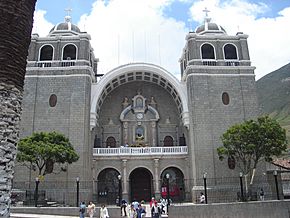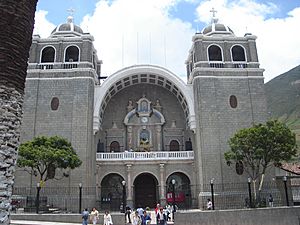Otuzco facts for kids
Quick facts for kids
Otuzco
|
|
|---|---|

The Cathedral of Otuzco
|
|
| Nickname(s):
capital of faith
|
|
| Country | |
| Region | La Libertad Region |
| Province | Otuzco Province |
| Incorporated (city) | November 15, 1890 |
| Elevation | 2,641 m (8,665 ft) |
| Population
(2005)
|
|
| • Total | 25,134 |
| • Density | 56.6/km2 (147/sq mi) |
| • Demonym | Otuzcan |
| Time zone | UTC-5 (PET) |
Otuzco is a city high up in the mountains of the La Libertad Region in Peru. It is the main city of the Otuzco Province. Otuzco is famous for its special church, which is home to the statue of the Virgin de la Puerta. This city is located at about 7°54′00″S 78°35′0″W / 7.90000°S 78.58333°W.
Contents
How Otuzco Was Founded
Otuzco became a province thanks to the efforts of local leaders. In 1856, Don José Corcuera and Don Enemecio Orbegozo suggested a new law. Don José Corcuera was a deputy, which is like a representative in the government. Don Enemecio Orbegozo was the son of a former president.
Their first idea for a law was not accepted. But they tried again! Their second idea was approved by the National Congress on April 17, 1861. This new law was called the "Law of Creation of the Otuzco Province."
The President of Peru, Ramón Castilla, signed this law on April 25, 1861. This law split the old Province of Huamachuco into two parts. It created the new Province of Otuzco. The town of Otuzco became the capital of this new province. Later, it was officially recognized as a city.
Life in Otuzco and Its Surroundings
People have lived in the Otuzco area for a very long time. The first groups of humans in the La Libertad Region settled here. Otuzco is an Andean city. Many people living here today are descendants of Peru's original people. They have also mixed with people who came from Spain a long time ago. Most residents are mestizo, meaning they have both Indigenous and European heritage.
The city was once home to the ancient Yungas and Quechuas people. Otuzco has narrow streets and houses with wide doors and tiled roofs. It is surrounded by beautiful Andean mountains. You can see the Tupullo Gorge, the Pollo River, and La Ermita mountain nearby. Many religious visitors come to Otuzco. They come to pray to the Virgin de la Puerta, who is the city's patron saint.
Over time, Otuzco's official status changed many times. It started as just a name, then became a parish, then a "curato," and later a town. When the Province of Otuzco was created, the town became a "Villa" (a larger town). Finally, on November 15, 1890, a law officially made Otuzco a city.
Geographical Features of Otuzco
The land around Otuzco is mostly steep and mountainous. It has many different natural features. You can find rugged valleys, tall hills, deep gorges, and narrow rivers. These rivers flow very fast through canyons.
There are hundreds of dirt tracks throughout the mountains of Otuzco. These tracks are the main roads for people in small communities. Donkeys are a very important way to travel here. People and donkeys use these narrow mountain paths every day.
Just a few kilometers from Otuzco, the land changes. It goes from hard, rocky ground to warm, fertile valleys. These lower valleys are almost tropical. They are famous for growing pineapples and sugar cane all year round.
The Festival of the Virgin De La Puerta
The Virgin de la Puerta is the special religious protector of Otuzco. The festival for the Virgin of La Puerta is a huge event. It happens in Otuzco during the second week of December. It is one of the most important religious celebrations in South America. Thousands of devoted people come to join in. They follow the statue of the Virgin as it moves through the streets.
For a whole week, religious pilgrims walk 73 kilometers. They walk from the city of Trujillo up through the mountains to Otuzco. This long walk is a way for believers to show their strong faith.
The festival includes three nights of celebrations. There are fireworks and traditional hot air balloons. More than twenty bands play traditional music. A highlight of the festival is the groups of dancers. They dress up as gypsies, African Slaves, pallas, coyas, and devils.
Another fun tradition is the "BurroCross" donkey race. Men show their skill by racing donkeys through the streets and mountain tracks. The week of celebrations ends on December 15. That's when huge bamboo castles of fireworks, three stories high, are lit up.
Economy of Otuzco
Otuzco's economy is based on farming and traditional products. Farmers grow wheat and potatoes. They also raise livestock like cows and sheep. The city is also known for its traditional baked goods.
Some of these products are sold right in Otuzco. The rest are taken to Trujillo to be sold in its markets. After selling their goods, people traditionally buy new items. These include clothing, shoes, electronics, and vegetables. They then sell these new products in Otuzco's markets.
Otuzco is a small mountain community. It has a simple, self-sufficient economy. People usually pay with cash. There are no big banks or automated teller machines (ATMs) in the city.
Communication in Otuzco
In recent years, modern communication has reached Otuzco. Electricity, mobile phone towers, and the internet have slowly spread. This includes the mountain areas around the city.
While some areas might not have signal due to the mountains, mobile phone coverage is good. It works well in and around the town. There are also several internet cafes in Otuzco. Here, people can go online.
Traveling to Otuzco
The journey to Otuzco starts from Trujillo, the capital of La Libertad. The trip takes about 1.5 to 2 hours. You can get to Otuzco by regular buses, Micros (small buses), or colectivos. Colectivos are cars where each passenger pays individually.
Transportation options range from cheap, basic buses to modern, reasonably priced ones. Colectivos are the fastest way to travel. However, they can sometimes be more risky. This is because they often drive faster on the winding mountain roads.
All transportation services to Otuzco leave from Avenida Union. This is a main road about 5 kilometers from downtown Trujillo. Travelers just need to choose which company they want to travel with. The road to Otuzco is modern and paved. It is usually well-maintained.
Tourism in Otuzco
Otuzco is a traditional mountain community. It's different from places like Cuzco, which are very focused on tourism. Otuzco has kept its traditional way of life. People still live as they have for many generations.
The city is 73 kilometers from Trujillo. You can visit it on a day trip by bus. There are also several hotels if you want to stay longer.
The main charm of Otuzco is its traditional lifestyle and customs. You'll see people wearing colorful traditional clothes. They sell their goods in the streets and markets. You'll also see them guiding their donkeys along the roads and trails. Most buildings in the town are still built in the old style. Otuzco is surrounded by beautiful mountains and gorges.
Education in Otuzco
Most education in Otuzco is provided by the government. However, a few private schools have opened recently. In the past, government education in Peru faced challenges. But in recent years, Peru's economy has grown. The government has invested more money in education.
You can see this improvement in small towns like Otuzco. Children now have access to computers, books, and other learning materials. The government has also spent a lot on improving schools. They are expanding, renovating, and modernizing schools in isolated communities. This includes areas in and around Otuzco. More investment in education, both from the government and private groups, will continue to help mountain communities.
Climate
| Climate data for Otuzco (Virgen de la Puerta), elevation 2,620 m (8,600 ft), (1990–2009) | |||||||||||||
|---|---|---|---|---|---|---|---|---|---|---|---|---|---|
| Month | Jan | Feb | Mar | Apr | May | Jun | Jul | Aug | Sep | Oct | Nov | Dec | Year |
| Mean daily maximum °C (°F) | 19.5 (67.1) |
18.9 (66.0) |
18.5 (65.3) |
19.2 (66.6) |
19.3 (66.7) |
19.6 (67.3) |
20.5 (68.9) |
20.9 (69.6) |
20.7 (69.3) |
20.4 (68.7) |
20.0 (68.0) |
19.4 (66.9) |
19.7 (67.5) |
| Mean daily minimum °C (°F) | 8.4 (47.1) |
8.1 (46.6) |
8.1 (46.6) |
8.0 (46.4) |
7.2 (45.0) |
5.9 (42.6) |
5.2 (41.4) |
5.3 (41.5) |
6.4 (43.5) |
7.7 (45.9) |
7.6 (45.7) |
7.7 (45.9) |
7.1 (44.8) |
| Average precipitation mm (inches) | 59.4 (2.34) |
90.7 (3.57) |
126.0 (4.96) |
95.1 (3.74) |
24.4 (0.96) |
11.6 (0.46) |
1.8 (0.07) |
4.6 (0.18) |
17.7 (0.70) |
32.6 (1.28) |
41.8 (1.65) |
36.5 (1.44) |
542.2 (21.35) |
| Average relative humidity (%) | 73.4 | 78.3 | 78.9 | 77.7 | 71.7 | 67.1 | 61.4 | 60.6 | 63.4 | 66.2 | 66.2 | 69.7 | 69.6 |
| Source: Sistema Nacional de Información Ambiental (precipitation and humidity 1994–2009) | |||||||||||||
See also
 In Spanish: Otuzco para niños
In Spanish: Otuzco para niños



